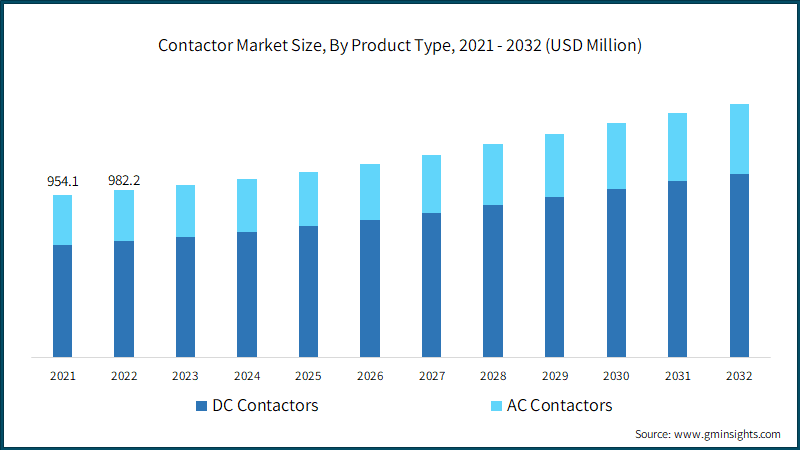Home > Energy & Power > Electrical Equipment > Contactor > Contactor Market
Contactor Market Analysis
- Report ID: GMI7008
- Published Date: Oct 2023
- Report Format: PDF
Contactor Market Analysis
Based on product type, the DC contactor is anticipated to grow at a CAGR of over 6.1% through 2032. Rise of industrial automation in conjunction with increasing concern for safety & reliability across electrical terminals in various end se industries will propel the market outlook. The industrial automation sector is increasingly utilizing DC contactors for applications such as motor control, robotics, and power distribution. These components are critical for ensuring precise control in automated processes.
- Energy efficiency and conservation are major market drivers as DC contactors are being designed to minimize energy losses and heat generation, making them more environmentally friendly and cost-effective.
- DC contactors are being integrated with digital control systems, enabling remote monitoring, predictive maintenance, and enhanced automation. These features improved operational efficiency and facilitated the development of smart grids and energy management systems.
- As various countries and regions implemented electrification initiatives and expanded the use of renewable energy sources, the demand for DC contactors in grid infrastructure and energy projects is on the rise, in turn fueling the product deployment.

Based on end use, the electric vehicle industry is set to record more than 6.5% growth rate from 2023 to 2032. The use of contactors in the electric vehicle (EV) industry is crucial for managing the flow of electrical power within the vehicle. Contactors serve as switches that open and close to control the circuit, allowing the safe and efficient operation of various electrical components in an EV.
- The rapid increase in the adoption of electric vehicles, driven by environmental concerns and government incentives, is a major trend. As more EVs are manufactured and sold, the demand for contactors has been on the rise.
- A wide variety of EVs operate on high-voltage systems to enhance power and efficiency, as a result, high-voltage contactors are in demand to manage the systems safely.
- Contactors are being integrated with sophisticated battery management systems (BMS) to optimize charging, discharging, and battery health, contributing to longer battery life.
- The electrification trend has extended beyond passenger cars to commercial vehicles like buses and trucks. These vehicles require robust contactors for managing higher power demands, further driving the market.

Asia Pacific contactor market is projected to witness around 6.4% CAGR through 2032. The Asia Pacific region is closely linked to economic and industrial growth, environmental considerations, technological advancements, and emerging applications including renewable energy and electric vehicles.
- Stringent environmental regulations are pushing manufacturers to adopt cleaner technologies and materials in the production of contactors. Compliance with these regulations is influencing product design and manufacturing processes.
- The integration of contactors with digital control systems and the Internet of Things (IoT) is gaining momentum. This enables remote monitoring, predictive maintenance, and enhanced automation in various applications.
- Infrastructure development projects, including smart cities, transportation networks, and power grids, are creating demand for advanced contactor solutions that can handle the unique requirements of these projects.
- The region is a significant market for electric vehicles and contactors plays an essential component in EVs for functions like battery disconnect, motor control, and charging. The increasing popularity of EVs has driven the demand for specialized contactors designed for automotive applications.

